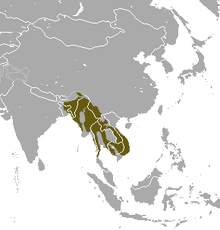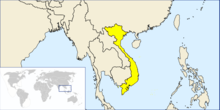Northern pig-tailed macaque
| Northern pig-tailed macaque[1] | |
|---|---|

| |
| M. leonina female with baby in Khao Yai National Park, Thailand | |
| Scientific classification | |
| Domain: | Eukaryota |
| Kingdom: | Animalia |
| Phylum: | Chordata |
| Class: | Mammalia |
| Order: | Primates |
| Suborder: | Haplorhini |
| Infraorder: | Simiiformes |
| Family: | Cercopithecidae |
| Genus: | Macaca |
| Species: | M. leonina
|
| Binomial name | |
| Macaca leonina (Blyth, 1863)
| |

| |
| Northern pig-tailed macaque range | |
The northern pig-tailed macaque (Macaca leonina) is a vulnerable species of
Physical characteristics

Appearance

Physical characteristics identifiers in distinguishing the northern and the southern pig-tailed macaques.[10] Northern pig-tailed macaques have a round greyish pelage from the side of their cheeks all the way around to the top of their head and beneath their chin, which is called a crown.[10] A brown pelage patch is found on the centre of their crowns followed by white triangular forms beneath this patch and along the top of their eyes.[10] One red stripe is found at each exterior corner of their eyes which are angled upwards and diagonally meeting at the ending point of the white triangular eye extremities.[10] Their elongated muzzle is still shorter when compared to southern pig-tailed macaques.[10]
On their backs, for mostly males, a black streak is found at the centre; and can sometimes have a red hue towards the top and black towards the bottom.[10] Moving downwards, their tails are composed of a thin pelage in a dark blackish hue and are shorter and skinnier than southern pig-tailed macaques.[10] Tail shapes vary, however, the most common is a 90 degree point to the back, followed by a 45 degree, a forward and parallel, a forward arch meeting its back, pointed downwards.[10] Beneath their tail, on their backside, there are oval shaped thick sitting pads that cover their hip bones, known as ischial callosities.[10]
Sex differences
The northern-pig tailed macaques have sexual dimorphic traits.[10] Body weight is the most obvious indicator to distinguish males from females, where males are found over eight kg give or take, and females below six kg.[11] Adult males are identified with defined shoulder musculature and exhibit red coloured sexual organs, such as their penis and anus.[12] Their tails are also found to be longer relative to females and their pelage has more darker contrast to it.[10] Adult females are smaller in size and are found to have sexual swelling in the same regions, yet are more vibrant red than in males.[12]
Male teenagers, known as subadult males, do not have red coloured sexual organs, yet have dropped testicles.[12] Infants fit into the age range of five to eight weeks old and are usually found eating solid foods, yet those older than nine weeks are studied to be independent of their mothers until a certain distance is travelled.[12] Newborns are up to four weeks old usually found feeding on breast milk, and are usually near their mother's stomachs while in motion or are cradled in their arms.[12]
Distribution and habitat
China
The Macaca leonina can also be found in tropical forests in

India
In India, the northern pig-tailed macaque is found south of the Brahmaputra River, in the northeastern part of the country.[14] Its range in India extends from Assam and Meghalaya to eastern Aruanchal Pradesh, Nagaland, Manipur, Mizoram and Tripura.[15] A detailed report on the ecology and behaviour of northern pig-tailed macaque has been published in 2008.[16]
Although no global population estimate is available, some site-based estimates are, including Keo Seima Wildlife Sanctuary in Cambodia, where an increasing population of almost 4,000 is reported.[17][18]
Thailand

Northern pig-tailed macaques are also found in Northeastern Thailand shown to be impacted by anthropogenic influences such as deforestation and forest alterations.[5] Their home range sizes vary from 62 to 828 hectares, similar to the southern pig-tailed macaques Macaca nemestrina.[5] However, their ability to travel is often limited due to habitat degradation and transformation with no limit to elevation unless there is less canopy cover per area.[13]
In the Sakaerat Biosphere Reserve, the region was about eighty kilometres of
Ecology and behaviour
Diet
Northern pig-tailed macaques are frugivorous as they tend to forage for hundreds of fruit species such as fleshy and dry; as well as flowers and buds, piths, leaves, and shoot species that makeup more than fifty percent of their diet.[5] Due to limited fruit availability in colder seasons or with habitat degradation, the macaques are found to become more omnivorous due to reliance on human food resources such as "rice, bread, biscuits"; and can also be found munching on fungi, ants, termites, spiders, stickbuds, grasshoppers, caterpillars, beetles, mushrooms, barks, eggs, lizards, and squirrels.[5][7]


Group strategies
Despite their limited and varied accessibility to their main food resources and habitat transformations, the northern pig-tailed macaques adapt to their environments by altering how their social groups are formed and composed.[7] Group sizes are shown to increase as a response to low connectivity within feeding sites, and tend to become more sedentary when relying on human food resources for nutrition.[7] The opposite is true for their group sizes and lifestyle within more wild environments, where smaller groups and nomadic patterns are more common.[7]
Groups are fairly large within this species which can exceed over one hundred fifty individuals.[20] However, they split into smaller groups when feeding and rejoin for larger group travel.[20] They are also found to vary their home range depending on the season, as the fruit availability and quality varies.[7] In low fruit abundance periods, the macaques are shown to travel to human settlements, which Gazagne et al., say is a practice of a "high-cost, high yield foraging strategy" as seen within plantation forests.[5][7] Northern pig-tailed macaques are found to prefer fruits from plantation forests when wild ones are scarce.[7] Their home range, however, increases as a result of high fruit abundance periods, where they are found settling near specific fruits species within forest habitats.[5][7] Therefore, they use different strategies to forage for food depending on what environments show abundance or low abundance, and their seasonality.[20] When plantations are abundant, they are found using more energy costs to travel to the region due to its high yields, therefore they are likely to increase their travels and trajectories.[20] When wild resources are abundant, such as within dry evergreen forests, the species uses less energy costs as they remain in smaller ranges to gain more yields.[12] However, with low abundance in both regions, the strategy is to create a balance between both strategies described above.[20]
Mating and reproduction
Social groups are matriarchal just like all macaque species are, therefore females exercise dominance within social groups.[6] Mating occurs when females attract males with reddened sexual skin swellings which occur due to hormone fluctuations during ovulation, their receptive period.[12][10] Female swellings are common signs of fertility that can continue past the periovulatory period.[12] The receptive period is identified with continuous mating patterns, where males practice a single or multiple mount process, within a few days in a row.[12] A visible sperm plug can also be identified during this period of copulation.[12] The duration of female pregnancies exceed the eight-month period for a single offspring and are followed by lactation for feeding newborns and infants up to two years of age.[12]
Threats
Viruses
Viruses are a common threat among northern pig-tailed macaques within degraded environments. For example, nonpathogenic
The researchers found that HIV-1 performed better, meaning that the infectious qualities and viral activity were less replicated within the immune system with (IFN)-a when compared to the pathogenic simian immunodeficiency virus.[8] They hypothesized that HIV's lower impact on the immune system in northern pig-tailed macaques can explain how HIV-1 does not reproduce and evolve into AIDS within the species.[8] The results show that naturally derived IFN-a is effective at preventing HIV-1 from further long term reproduction, yet SIVmac239 needs to be monitored to prevent further chronic illness.[8] Northern pig-tailed macaques were also reported to be affected by coronavirus 2 (SARS-CoV-2) and was shown to be fatal and highly transmissible.[9]


Human impacts
According to the ICUN red list, the northern pig-tailed macaque is considered vulnerable and declining.[3] This species is affected by human impacts such as agricultural expansions, aquaculture, transportation infrastructure, hunting and logging for meat and trophies, and the illegal pet trade; that result in habitat loss and forest fragmentation.[7][3] With these influences, this species is found raiding crops and their main sources of fresh nutrition are limited, minimally available, and less accessible depending on the season.[19]
Pet trade
A study done between 2015 and 2019 in
Additionally, northern pig-tailed macaques were observed as the highest kept macaque out of the range of captive macaque species in Vietnam; and were found in various locations from cages on personal property to hotels and restaurants.[9] Due to exposure from non-governmental organizations, this issue started to gain awareness among the public and authorities, yet rescue centres are often at full capacity; which continues the cycle of releasing macaques without proper identification, protection, and disease screening.[9] The authors suggest data collection on the macaque species within Vietnam to address the severity of the pet trade on their survival and conservation, increasing the accessibility of confiscation and release records, training on confiscation and rehabilitation, and improving the global spread of information addressing the impacts of the pet trade on non-human primates survival and well-being.[9]
Gallery
-
Mother with infant in Khao Yai National Park, Thailand
-
Male adult in Khao Yai National Park, Thailand
-
Female adult at a monkey school on Ko Lanta Yai, Thailand
-
Female adult at Hoollongapar Gibbon Sanctuary, India
-
Pet juvenile grooming household chicken on Khong Island, Laos
-
Female by the tree trunk in her natural habitat
-
Female and an infant breastfeeding
References
- OCLC 62265494.
- ^ . Retrieved 13 November 2021.
- ^ a b c d Boonratana, R; Chetry, D; Yongcheng, L; Jiang, X.L; Htun, S; Timmins, R.J (2022). "Macaca leonina". IUCN Red List.
- ^ PMID 29491927.
- ^ S2CID 1782457.
- ^ )
- ^ S2CID 211556619.
- ^ PMID 35331910.
- ^ PMID 33396881.
- ^ S2CID 12112964.
- S2CID 12112964.
- ^ S2CID 232300829.
- ^ S2CID 210934233.
- S2CID 86707943.
- ^ Choudhury, A. U. (2003). "The pig-tailed macaque Macaca nemestrina in India - status and conservation". Primate Conservation. 19: 91–94.
- ^ Choudhury, A. U. (2008). "Ecology and behaviour of the pigtailed macaque Macaca nemestrina leonina in some forests of Assam in North-East India". J. Bombay Nat. Hist. Soc. 105 (3): 279–291.
- S2CID 245405123.
- S2CID 229677607.
- ^ S2CID 220541585.
- ^ PMID 36139272.







